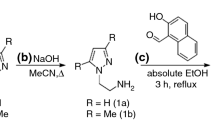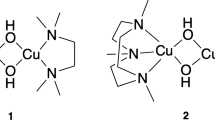Abstract
A quantum chemistry study of mononuclear metal coordination with four 4-methylimidazole ligands (4-MeIm) was investigated. The four complexes [Cu(4-MeIm)4]2+, [Cu(4-MeIm)4, H2O]2+, [Zn(4-MeIm)4]2+ and [Zn(4-MeIm)4, H2O]2+ were studied with particular attention to the Nπ or Nτ possible coordinations of the 4-MeIm ring with the metals, using different DFT methods. The results suggest that the Nτ coordination of 4-MeIm ring to ZnII or CuII is more favorable whatever the level of calculation. In contrast, the addition of one water molecule in the first coordination sphere of the metal ions provides five-coordinated complexes showing no Nπ or Nτ preferences. There is good agreement between the DFT-calculated structure and those available experimentally. When metal ions are four-fold coordinated, they adopt a tetrahedral geometry. When CuII and ZnII are five-fold coordinated, highly symmetric structures or intermediate structures are calculated. Similar energies are calculated for different structures, suggesting flat potential energy surfaces. The addition of implicit solvent modifies the calculated first coordination sphere, especially for [Cu(4-MeIm)4, H2O]2+ structures. The QTAIM and ELF topological analyses of the interaction between CuII and the neutral ligands, clearly indicate a dative bonding with a strong ionic character.






Similar content being viewed by others
References
Degtyar E, Harrington MJ, Politi Y et al (2014) The mechanical role of metal ions in biogenic protein-based materials. Angew Chem Int Ed 130:16156–16157. doi:10.1002/anie.201404272
Kogot JM, England HJ, Strouse GF, Logan TM (2008) Single peptide assembly onto a 1.5-nm Au surface via a histidine tag single peptide assembly onto a 1.5-nm Au surface via a histidine tag. J Am Chem Soc 130:16156–16157. doi:10.1021/ja8064717
Barszcz B, Glowiak T, Jezierska J (1999) Crystal and molecular structures of eight-coordinate (CuN4O4) and six-coordinate (CuN4O2) Cu(II) complexes with 4-methyl-5-imidazole-carboxaldehyde or 1-benzyl-2-hydroxymethylimidazole, respectively. Spectroscopic and potentiometric studies. Polyhedron 18:3713–3721
Andreini C, Bertini I, Cavallaro G (2011) Minimal functional sites allow a classification of zinc sites in proteins. PLoS ONE. doi:10.1371/journal.pone.0026325
Karlin S, Zhu ZY (1997) Classification of mononuclear zinc metal sites in protein structures. Proc Natl Acad Sci U S A 94:14231–14236. doi:10.1073/pnas.94.26.14231
Hough MA, Strange RW, Hasnain SS (2000) Conformational variability of the Cu site in one subunit of bovine CuZn superoxide dismutase: the importance of mobility in the Glu119-Leu142 loop region for catalytic function. J Mol Biol 304:231–241. doi:10.1006/jmbi.2000.4186
Ferrer P, Jiménez-Villacorta F, Rubio-Zuazo J et al (2014) Environmental influence on Zn-histidine complexes under no-packing conditions. J Phys Chem B 118:2842–2850. doi:10.1021/jp411655e
Fermi E (1927) Un metodo statistico per la determinazione di alcune proprietá dell’atomo. Rend Accad Naz Lincei 6:602–607
Zhao Y, Truhlar DG (2008) The M06 suite of density functionals for main group thermochemistry, thermochemical kinetics, noncovalent interactions, excited states, and transition elements: two new functionals and systematic testing of four M06-class functionals and 12 other function. Theor Chem Accounts 120:215–241. doi:10.1007/s00214-007-0310-x
Lee C, Yang W, Parr RG (1988) Development of the Colle-Salvetti correlation-energy formula into a functional of the electron density. Phys Rev B 37 (2):785–789
Grimme S, Antony J, Ehrlich S, Krieg H (2010) A consistent and accurate ab initio parametrization of density functional dispersion correction (DFT-D) for the 94 elements H-Pu. J Chem Phys. doi:10.1063/1.3382344
Ditchfield R, Hehre WJ, Pople JA (1971) Self-consistent molecular-orbital methods. IX. An extended Gaussian-type basis for molecular-orbital studies of organic molecules. J Chem Phys 54:724. doi:10.1063/1.1674902
Dolg M, Stoll H, Preuss H, Pitzer RM (1993) Relativistic and correlation effects for element 105 (hahnium, Ha): a comparative study of M and MO (M = Nb, Ta, Ha) using energy-adjusted ab initio pseudopotentials. J Phys Chem 97:5852–5859. doi:10.1021/j100124a012
Hay PJ, Wadt WR (1985) Ab initio effective core potentials for molecular calculations. Potentials for the transition metal atoms Sc to Hg. J Chem Phys 82:270. doi:10.1063/1.448799
Cossi M, Scalmani G, Rega N, Barone V (2002) New developments in the polarizable continuum model for quantum mechanical and classical calculations on molecules in solution. J Chem Phys 117:43. doi:10.1063/1.1480445
Cossi M, Rega N, Scalmani G, Barone V (2003) Energies, structures, and electronic properties of molecules in solution with the C-PCM solvation model. J Comput Chem 24:669–681. doi:10.1002/jcc.10189
Frisch MJ, Trucks GW, Schlegel HB, Scuseria GE, Robb MA, Cheeseman JR, Scalmani G, Barone V, Mennucci B, Petersson GA, Nakatsuji H, Caricato M, Li X, Hratchian HP, Izmaylov AF, Bloino J, Zheng G, Sonnenberg JL, Had M, Frisch MJ, Trucks GW, Schlegel HB, Scuseria GE, Robb MA, Cheeseman JR, Scalmani G, Barone V, Mennucci B, Petersson GA, Nakatsuji H, Caricato M, Li X, Hratchian HP, Izmaylov AF, Bloino J, Zheng G, Sonnenberg JL, Had M, Fox DJ (2013) Gaussian 09, Revision D.01. Gaussian Inc, Wallingford. doi:10.1017/CBO9781107415324.004
Dennington R, Keith T, Millam J (2009) GaussView, version 5. Semichem Inc, Shawnee Mission
Humphrey W, Dalke A, Schulten K (1996) VMD: visual molecular dynamics. J Mol Graph 14:33–38. doi:10.1016/0263-7855(96)00018-5
Noury S, Krokidis X, Fuster F, Silvi B (1999) Computational tools for the electron localization function topological analysis. Comput Chem 23:597–604. doi:10.1016/S0097-8485(99)00039-X
Portmann S, Lüthi HP (2000) MOLEKEL: an interactive molecular graphics tool. Chimia 54:766–770
T. A. Keith (2016) AIMAll (Version 16.01.09), TK Gristmill Software, Overland Park KS U (aim.tkgristmill.com)
Bader RFW (1990) Atoms in molecules. 59773335. doi: 10.1002/0470845015.caa012
Macchi P, Proserpio DM, Sironi A (1998) Experimental electron density in a transition metal dimer: metal-metal and metal-ligand bonds. J Am Chem Soc 120:13429–13435. doi:10.1021/ja982903m
Becke AD, Edgecombe KE (1990) A simple measure of electron localization in atomic and molecular systems. J Chem Phys 92:5397–5403. doi:10.1063/1.458517
Silvi B, Savin A (1994) Classification of chemical-bonds based on topological analysis of electron localization functions. Nature 371:683–686. doi:10.1038/371683a0
Silvi B, Fourre I, Alikhani ME (2005) The topological analysis of the electron localization function. A key for a position space representation of chemical bonds. Monatshefte Fur Chem 136:855–879. doi:10.1007/s00706-005-0297-8
Poater J, Duran M, Solà M, Silvi B (2005) Theoretical evaluation of electron delocalization in aromatic molecules by means of atoms in molecules (AIM) and electron localization function (ELF) topological approaches. Chem Rev 105:3911–3947. doi:10.1021/cr030085x
Silvi B, Gillespie RJ, Gatti C (2013) Compr Inorg Chem II. doi:10.1016/B978-0-08-097774-4.00907-4
Lepetit C, Silvi B, Chauvin R (2003) ELF analysis of out-of-plane aromaticity and in-plane homoaromaticity in carbon[N]annulenes and [N]pericyclynes. J Phys Chem A 107:464–473. doi:10.1021/jp026521l
Silvi B (2004) How topological partitions of the electron distributions reveal delocalization. Phys Chem Chem Phys 6:256–260. doi:10.1039/b311272a1
Hough MA, Hasnain SS (2003) Structure of fully reduced bovine copper zinc superoxide dismutase at 1.15 Å. Structure 11:937–946. doi:10.1016/S0969-2126(03)00155-2
Hakansson K, Carlsson M, Svensson LA, Liljas A (1992) Structure of native and apo carbonic anhydrase II and structure of some of its anion-ligand complexes. J Mol Biol 227:1192–1204. doi:10.1016/0022-2836(92)90531-N
Branco RJF, Fernandes PA, Ramos MJ (2006) Molecular dynamics simulations of the enzyme Cu, Zn superoxide dismutase. J Phys Chem B 110:16754–16762. doi:10.1021/jp056855l
Xerri B, Petitjean H, Dupeyrat F et al (2014) Mid- and far-infrared marker bands of the metal coordination sites of the histidine side chains in the protein Cu, Zn-superoxide dismutase. Eur J Inorg Chem 2014:4650–4659. doi:10.1002/ejic.201402263
Liu S, Wu Q, Schmider HL et al (2000) Syntheses, structures, and electroluminescence of new blue/green. J Am Chem Soc 122:3671–3678
Yue SM, Bin XH, Ma JF et al (2006) Design and syntheses of blue luminescent zinc(II) and cadmium(II) complexes with bidentate or tridentate pyridyl-imidazole ligands. Polyhedron 25:635–644. doi:10.1016/j.poly.2005.07.021
Ohtsu H, Shimazaki Y, Odani A et al (2000) Synthesis and characterization of imidazolate-bridged dinuclear complexes as active site models of Cu, Zn-SOD. J Am Chem Soc 122:5733–5741. doi:10.1021/ja994050j
Chen P, Solomon EI (2004) Oxygen activation by the noncoupled binuclear copper site in peptidylglycine alpha-hydroxylating monooxygenase. Reaction mechanism and role of the noncoupled nature of the active site. J Am Chem Soc 126:4991–5000. doi:10.1021/ja031564g
Blackburn NJ, Rhames FC, Ralle M, Jaron S (2000) Major changes in copper coordination accompany reduction of peptidylglycine monooxygenase: implications for electron transfer and the catalytic mechanism. J Biol Inorg Chem 5:341–353
Pasquarello A, Petri I, Salmon PS et al (2001) First solvation shell of the Cu(II) aqua ion: evidence for fivefold coordination. Science 291:856–859. doi:10.1126/science.291.5505.856
Díaz N, Suarez D, Sordo TL (2006) Quantum chemical study on the coordination environment of the catalytic zinc ion in matrix metalloproteinases. J Phys Chem B 110:24222–24230. doi:10.1021/jp0656882
Espinosa E, Molins E, Lecomte C (1998) Hydrogen bond strengths revealed by topological analyses of experimentally observed electron densities. Chem Phys Lett 285:170–173. doi:10.1016/S0009-2614(98)00036-0
Espinosa E, Alkorta I, Rozas I et al (2001) About the evaluation of the local kinetic, potential and total energy densities in closed-shell interactions. Chem Phys Lett 336:457–461. doi:10.1016/S0009-2614(01)00178-6
Acknowledgments
Calculations (projects x2015087394 and x2016087394) were carried out on the IBM SP4 computers of the CINES (Centre Informatique National de l’Enseignement Supérieur) in Montpellier (France) and of the IDRIS (Institut des Ressources en Informatique Scientifique) in Orsay (France). MB is grateful to MESRS (Ministère de l’Enseignement Supérieur et de la Recherche Scientifique), Tunisia for an 11-month grant.
Author information
Authors and Affiliations
Corresponding author
Additional information
This paper belongs to Topical Collection Festschrift in Honor of Henry Chermette.
Electronic supplementary material
Below is the link to the electronic supplementary material.
ESM 1
(DOCX 279 kb)
Rights and permissions
About this article
Cite this article
Boukallaba, M., Kerkeni, B., Lepetit, C. et al. Coordination complexes of 4-methylimidazole with ZnII and CuII in gas phase and in water: a DFT study. J Mol Model 22, 301 (2016). https://doi.org/10.1007/s00894-016-3167-x
Received:
Accepted:
Published:
DOI: https://doi.org/10.1007/s00894-016-3167-x




